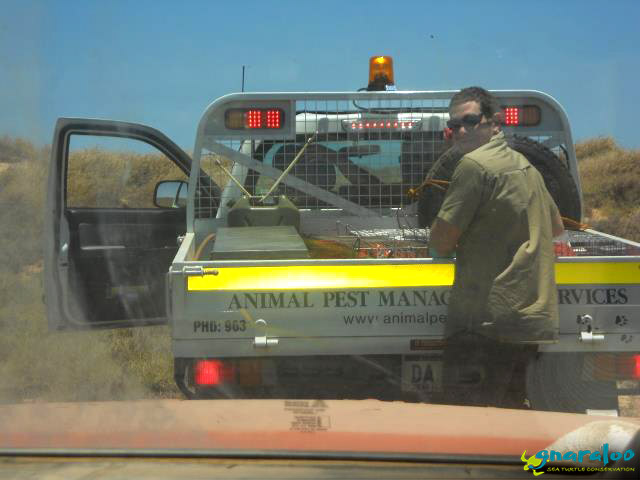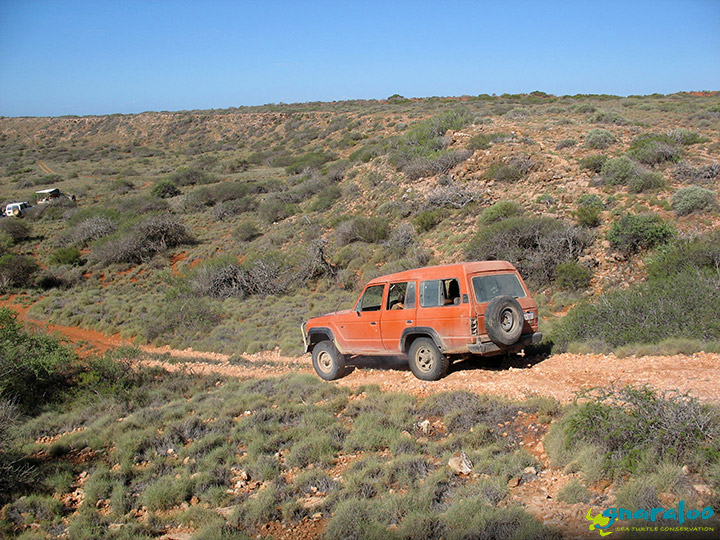Hello all GTCP friends! As noted on the Gnaraloo Bay Turtle Thermometer, the GTCP monitoring…

Training in predator track identification
We recently received training in predator track identification by Mike Butcher and his team from Animal Pest Management Services (APMS), including Shane and Dean Butcher. APMS is responsible for undertaking the required on-ground works at Gnaraloo under the Gnaraloo Fox Control Program.
On 18 November 2011 and 20 November 2011, the APMS team was kind enough to let us accompany them as they surveyed targeted areas on Gnaraloo for signs of foxes, feral cats and wild dogs. Tracking and baiting efforts at Gnaraloo initially focused on the European Red Fox (Vulpes vulpes) given significant previous predation of turtle eggs and hatchlings by foxes before commencement of the program to eradicate introduced predators. The Gnaraloo Fox Control Program has been expanded since then to target feral cats and wild dogs as well. During our time with APMS, they placed baits specially prepared with 1080 poison in strategic locations at Gnaraloo, including areas where foxes were evident (i.e. either foxes or fox tracks had been observed by us, station staff or by APMS) and where fox presence was likely to be high (such as around potential pathways and water points). 1080 is found in at least 39 native plant species in Western Australia and native fauna has a high tolerance to it. It is considered to be the most efficient vertebrate pest control method currently available in Western Australia. At the start of the Gnaraloo Fox Control Program in 2008, baiting works focused on protecting turtles breeding at the Gnaraloo Bay Rookery. Each year since then, the program has been expanded and it now covers all accessible areas on Gnaraloo Station. Because guests sometimes bring their dogs on holiday with them, baiting is not undertaken at or around 3Mile Camp or the Homestead precinct or the public beach area at Gnaraloo Bay. However, please note that fox baits are laid in and surrounding the 6Mile area that is used by guests and the public for shore fishing as this is essential to protect the Gnaraloo Bay Rookery.
1080 baits are toxic to dogs and, for this reason, dogs must be kept on a leash when at Gnaraloo.
The Gnaraloo Fox Control Program resulted in 0% fox disturbance and predation of turtles breeding at the Gnaraloo Bay Rookery during the turtle breeding season 2010/11. It has also had other positive outcomes as well such as biodiversity conservation through protection of other native fauna station wide, such as small to medium sized mammals, marsupials, ground nesting birds and reptiles. The program runs in addition to and compliments the bio-security control program for the Ningaloo coast under the Bio-security and Agriculture Management Act 2007.
Receiving the onsite training by APMS in predator track identification has been very valuable as last year’s GTCP scientific team had to learn how to identify and distinguish predator tracks based on catalogued photos only in the GTCP Photo Training Database. We’d like to warmly thank Mike, Shane and Dean for sharing their knowledge to help us to better track predator activity in and near the Gnaraloo rookeries which are monitored by us. We are confident that we would now be able to accurately identify fox tracks, feral cat tracks and wild dog tracks, which can be quite difficult at times given track erosion by the strong winds prevalent on the Gnaraloo beaches during this time of year!
Cheers, Kimmie




